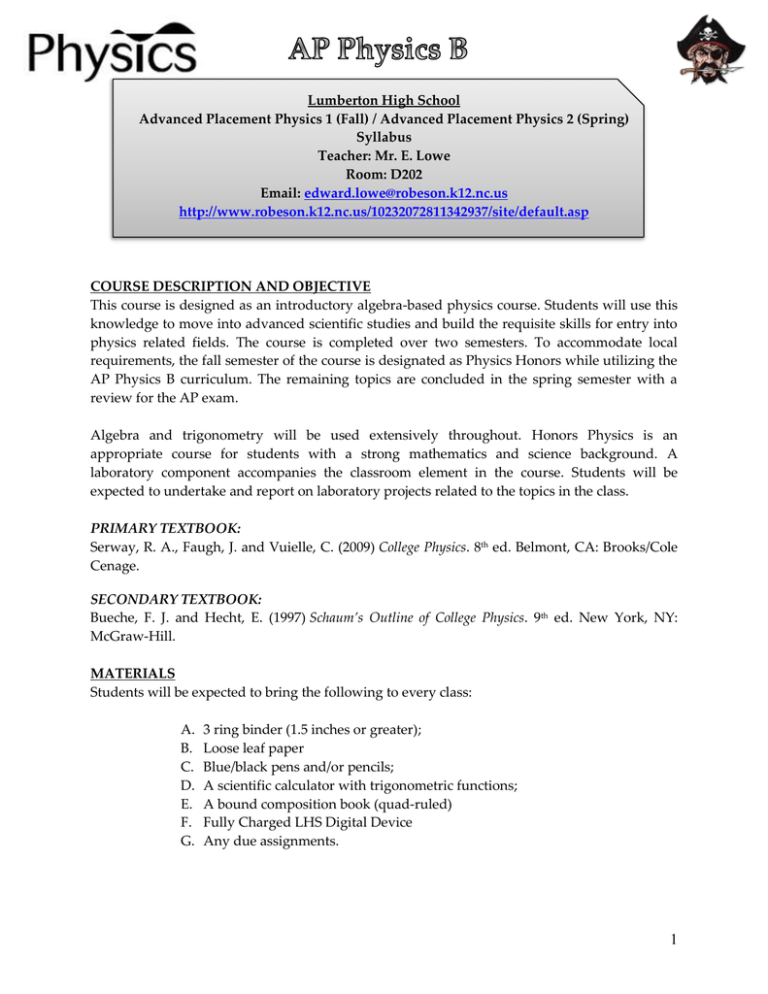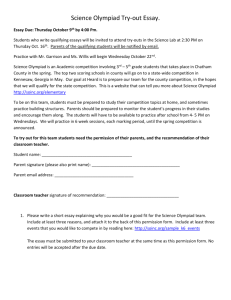Syllabus
advertisement

Lumberton High School Advanced Placement Physics 1 (Fall) / Advanced Placement Physics 2 (Spring) Syllabus Teacher: Mr. E. Lowe Room: D202 Email: edward.lowe@robeson.k12.nc.us http://www.robeson.k12.nc.us/10232072811342937/site/default.asp COURSE DESCRIPTION AND OBJECTIVE This course is designed as an introductory algebra-based physics course. Students will use this knowledge to move into advanced scientific studies and build the requisite skills for entry into physics related fields. The course is completed over two semesters. To accommodate local requirements, the fall semester of the course is designated as Physics Honors while utilizing the AP Physics B curriculum. The remaining topics are concluded in the spring semester with a review for the AP exam. Algebra and trigonometry will be used extensively throughout. Honors Physics is an appropriate course for students with a strong mathematics and science background. A laboratory component accompanies the classroom element in the course. Students will be expected to undertake and report on laboratory projects related to the topics in the class. PRIMARY TEXTBOOK: Serway, R. A., Faugh, J. and Vuielle, C. (2009) College Physics. 8th ed. Belmont, CA: Brooks/Cole Cenage. SECONDARY TEXTBOOK: Bueche, F. J. and Hecht, E. (1997) Schaum’s Outline of College Physics. 9th ed. New York, NY: McGraw-Hill. MATERIALS Students will be expected to bring the following to every class: A. B. C. D. E. F. G. 3 ring binder (1.5 inches or greater); Loose leaf paper Blue/black pens and/or pencils; A scientific calculator with trigonometric functions; A bound composition book (quad-ruled) Fully Charged LHS Digital Device Any due assignments. 1 GRADING SCALE Every classroom teacher shall use the following grading scale to measure student progress: 96 %or >=4.000 95%= 3.875 94%= 3.750 93%= 3.625 92%= 3.500 91%= 3.375 90%= 3.250 89%= 3.125 88%= 3.000 87%= 2.875 86%= 2.750 85%= 2.625 84%= 2.500 83%= 2.375 82%= 2.250 81%= 2.125 80%= 2.000 79%= 1.875 78%= 1.750 77%= 1.625 76%= 1.500 75%= 1.375 74%= 1.250 73%= 1.125 70-72%= 1.000 < 69%= 0.000 GRADING PROCEDURE: MAJOR TESTS QUIZZES Percent of 9 Weeks Grade 35% 10% CW/COLLABORATION 15% LABS/HOMEWORK PROJECTS 20% 20% Grade Criteria FINAL EXAM Sample Activities 1 per Unit of Study & cumulative Pop Quiz & Reflections WebAssign (Donated by Academic Boosters) Lab notebook & Free Response Questions Big Idea Activities, Google Sites 25% of Each Semester Grade TESTS: One test will be given per chapter or unit of material. Test dates will be announced at least 3 days prior to the test. Test corrections are due two class meetings after receiving original test grade. Proper correction of missed items provides an opportunity for mastery of the subject and will result in an increased grade. QUIZZES: Quizzes will be announced and unannounced. Reflections posted on student Google site (e-portfolio) will be counted as quiz grades. LABS: Laboratory experiments are an integral part of scientific discovery and will be an essential component of this course. Evaluation will be in the form of notebook checks each grading period and a laboratory report posted on the student Google site (eportfolio) after each lab. Laboratory Reports are due three class meetings after the lab is completed and must be visible to the instructor on the student’s Google site to receive full credit. General Laboratory Safety Rules will be provided for each experiment. Labs cannot be made up. Unsafe procedures and incorrect techniques will result in lowered grades and possible disciplinary action. 2 HOMEWORK: Problems will be assigned on a per section/chapter basis. The homework due dates per section will be announced by the instructor at least one day prior to its due date. There is a high correlation between arriving at the problem session prepared and success in the course. Problems submitted on paper for a grade should be neatly solved and include diagrams, vector diagrams (if applicable), a list of the given information, all necessary steps to solve the problem and the boxed answer. A ruler should be used for all diagrams and graphs. Graphs must be on graph paper or they must be computer generated. PROJECTS: Projects will be assigned throughout the course. Most projects will only require a couple of weeks of preparation prior to submission and students will be provided ample time to complete the project. CLASS PARTICIPATION: Class participation will be evaluated on an individual basis and will depend on class discussions, question-answer sessions, and lab participation. ABSENCE POLICY/MISSED WORK POLICY A. You will have five days to make up missed homework and it is YOUR responsibility to have it done. All work will be listed on the course website listed above. B. If you are absent during a test or quiz you have 5 school days to make it up with me. Anything made up after that without a valid excuse (e.g. doctor’s note) will not be accepted. C. There are no make-ups for make-ups. LEARNING CENTER Students may receive tutoring, make up tests and other missing assignments, and do retests during Learning Center after school in my classroom. Other opportunities for assistance may be scheduled in advance if I do not have another commitment. Students may retest on any major test. This will be done within two weeks of the original test date and only after test corrections have been done. The two grades will be averaged and the improved grade will be recorded for that test. ACADEMIC HONESTY Academic evaluations in this course require that the student’s work be free from academic dishonesty of any type. Evidence of cheating, plagiarism, abuse of academic materials, or fabrication of information will cause adverse affects to grades and possible disciplinary action. 3 SCIENCE OLYMPIAD LHS fields a Science Olympiad team that prepares throughout the year for tournaments. Science Olympiad competitions are like academic track meets, consisting of a series of 23 team events in each division. By combining events from many disciplines, like anatomy, physics, geology, astronomy, mechanical engineering and technology, Science Olympiad encourages a wide cross-section of students to get involved in active, hands-on, group participation. Active Participation in the LHS Science Olympiad team will result in the following compensation for AP PHYSICS: Lowest test score for each 9 weeks will be dropped. Enrichment topic after the AP Exam will be forgiven. CLASS RULES A. All materials in class (fully charged); B. Raise your hand before speaking; C. The cheater and the facilitator will both receive zeros for that assignment; D. Food or drinks will not be allowed in the classroom at any time. E. Golden Rule – Work hard and respect me and I will work twice as hard to meet you 4 TWO SEMESTER COURSE OUTLINE Unit 1: (2 weeks) Mathematical Reasoning I. A. Algebra Review B. Dimensional Analysis C. Data Analysis D. Vector Addition Newtonian Mechanics Unit 2: (2.5 weeks) A. Unit 3: Kinematics 1. Motion in one dimension 2. Motion in two dimensions (2.5 weeks) B. Unit 4: Newton’s Laws of Motion 1. Static Equilibrium (first law) 2. Dynamics of a single particle (second law) 3. Systems of two or more objects (third law) (2.5 weeks) C. D. Unit 5: Work, energy, power 1. Work and the work-energy theorem 2. Forces and potential energy 3. Conservation of energy 4. Power Systems of particles, linear momentum 1. Impulse and momentum 2. Conservation of linear momentum, collisions (2 weeks) E. F. Circular motion and rotation 1. Uniform circular motion 2. Torque and rotational statics Gravitation 1. Newton’s law of gravity 2. Orbits of planets and satellites 5 II. Fluid Mechanics and Thermal Physics Unit 6: (2 weeks) A. Unit 7: 1. Hydrostatic pressure 2. Buoyancy 3. Fluid flow continuity 4. Bernoulli’s equation (2 weeks) B. C. III. Fluid Mechanics Temperature and heat 1. Mechanical equivalent of heat 2. Heat transfer and thermal expansion Kinetic theory and thermodynamics 1. Ideal gases 2. Laws of thermodynamics Electricity and Magnetism Unit 8: (2.5 weeks) A. B. Unit 9: Electrostatics 1. Charge and Coulomb’s Law 2. Electric field and electric potential (including point charges) Conductors and capacitors 1. Electrostatics with conductors 2. Capacitors (2.5 weeks) C. Unit 10: D. E. Electric circuits 1. Current, resistance, power 2. Steady-state direct current circuits with batteries and resistors only 3. Capacitors in circuits (2.5 weeks) Magnetic Fields 1. Forces on moving charges in magnetic fields 2. Forces on current-carrying wires in magnetic fields 3. Fields of long current-carrying wires Electromagnetism 1. Electromagnetic induction (including Faraday’s law and Lenz’s law) 6 IV. Waves and Optics Unit 11: A. Unit 12: B. C. Unit 13: V. (2.5 weeks) Wave motion (including sound) 1. Simple harmonic motion (dynamics and energy relationships) 2. Mass on a spring 3. Pendulum and other oscillations 4. Traveling waves 5. Wave propagation 6. Standing waves 7. Superposition (2.5 weeks) Physical optics 1. Interference and diffraction 2. Dispersion of light and the electromagnetic spectrum Geometric optics 1. Reflection and refraction 2. Mirrors 3. Lenses (2 weeks) Atomic and Nuclear Physics A. B. Atomic physics and quantum effects 1. Photons, the photoelectric effect, Compton scattering, x-rays 2. Atomic energy levels 3. Wave-particle duality Nuclear Physics 1. Nuclear reactions (including conservation of mass number and charge) 2. Mass-energy equivalence 7 PLEASE COMPLETE THE INFORMATION BELOW AND RETURN I have read the course syllabus for Physics Honors / AP Physics B and understand the requirements and evaluation of academic proficiency. Student signature:______________________________________________ Parent Signature:______________________________________________ Best Time/ Method / Info to Contact Parent: __________ a.m. p.m. Phone / e-mail / ________________________________ Phone Number or email address Are there any special conditions that I need to consider when it comes to teaching your child? ______________________________________________________________________________ __________________________________________________________________ Allergies? ______________________________________________________________________________ __________________________________________________________________ If needed, can your child stay after school one or two days per week for tutoring? ____________ Do you have a computer at home and/or will you be receiving an LHS digital device? ______________ Do you have Internet Access at home? ______________ Thank you Mr. Edward Lowe 8

